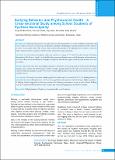Please use this identifier to cite or link to this item:
https://hdl.handle.net/20.500.14356/1603| Title: | Bullying Behavior and Psychosocial Health – A Cross-sectional Study among School Students of Pyuthan Municipality |
| Authors: | Mishra, Durga Khadka Thapa, Tulsi Ram Marahatta, Sujan Babu Mahotra, Anita |
| Citation: | MishraD. K., ThapaT. R., MarahattaS. B., & MahotraA. (2018). Bullying Behavior and Psychosocial Health – A Cross-sectional Study among School Students of Pyuthan Municipality. Journal of Nepal Health Research Council, 16(1), 73-78. https://doi.org/10.33314/jnhrc.v16i1.1366 |
| Issue Date: | 2018 |
| Publisher: | Nepal Health Research Council |
| Article Type: | Original Article |
| Keywords: | Bullying behavior Nepal Psychosomatic health School students |
| Series/Report no.: | Jan - Mar 2018;1366 |
| Abstract: | Abstract Background: Bullying remains as pervasive phenomenon affecting children worldwide. Bullying in school has long been a matter of concern as wide range of adjustment problems including poor mental health and violent behavior in school are associated with it. The present study examined the prevalence of bullying behavior (bullies, victims and bully-victims) and their association with depression and psychosomatic symptoms. Methods: A cross-sectional descriptive study was carried out among 8th, 9th and 10th grade students of Pyuthan Municipality, Mid-Western Nepal. A total of 405 students responded to the structured self-administered questionnaire. Data was collected from randomly selected public and private schools. Descriptive and inferential statistics were used for analysis. Results: The result of this study showed higher prevalence of bully (55.8%) among students of Relatively Advantaged Janajati whereas victims (64.86%) belonged to Disadvantaged Janajatis. Students who bully were found more in grade 8 and 10 whilst the students of grade 9 were more victims. Bullying behavior prevailed more in private schools than in public schools. Conclusions: The overall prevalence of bullying behavior (either bully or victim) is 69.14%. The finding bolsters an association between bullying behavior and depression, psychosomatic symptoms and school type. Higher prevalence of bullying behavior suggested by this study portends the alarming consequences among school students. Bullying needs to be addressed fleetly. Effective interventions that reduce bullying practice in school is essential. |
| Description: | Original Article |
| URI: | http://103.69.126.140:8080/handle/20.500.14356/1603 |
| ISSN: | Print ISSN: 1727-5482; Online ISSN: 1999-6217 |
| Appears in Collections: | Vol. 16 No. 1 Issue 38 Jan-Mar 2018 |
Files in This Item:
| File | Description | Size | Format | |
|---|---|---|---|---|
| 1366-Manuscript-3927-2-10-20180314.pdf | Full text Article | 178.56 kB | Adobe PDF |  View/Open |
Items in DSpace are protected by copyright, with all rights reserved, unless otherwise indicated.
